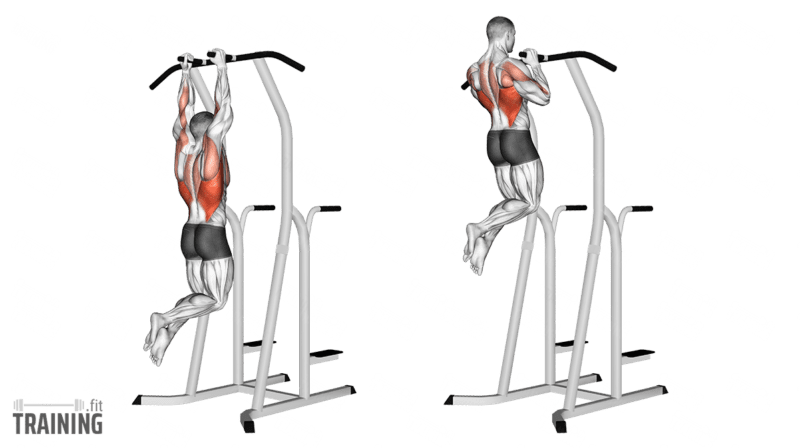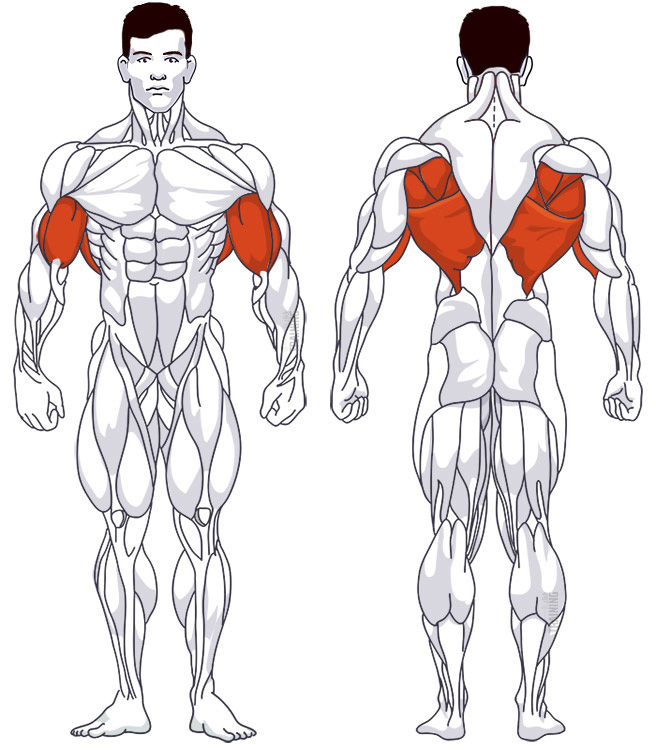Hammer Grip Pull-Ups
Compound exercise, Body weightThis article is verified by 1 study/publication.
Overview

Main muscles
- Biceps: Arm flexor
(Musculus biceps brachii) - Upper arm: Coracobrachialis muscle
(Musculus coracobrachialis) - Back: Large round muscle
(Musculus teres major) - Back: Large back muscle
(Musculus latissimus dorsi) - Back: Larger rhomboid muscle
(Musculus rhomboideus major) - Back: Small round muscle
(Musculus teres minor)
Training plans
Hammer Grip Pull-Ups is a suitable substitute for similar exercises in upper back training or as a supplement to various training plans.
Hammer Grip Pull-Ups: Basics and alternatives

Involved main muscle groups:
Hammer Grip Pull-Ups
Hammer grip pull-ups are a different grip variation of regular pull-ups. The movement is the same: Hang from a bar and pull your body up until your chin is level with your hands.
The main difference from overhand pull-ups is the hand and arm posture. With the hammer grip, your palms face each other. As a result, your biceps, middle deltoid, and upper pectoral muscles are activated more than in the overhand grip, while lat and neck muscles are less stressed.[1]
Hammer grip pull-ups are an interesting alternative to overhand grip pull-ups if you want to focus on other muscle groups involved. With greater biceps involvement, they’re usually easier for beginners, providing a better introduction to the exercise when normal pull-ups are too difficult.
Correct execution
Most pull-up bars with hammer grip options offer two grip widths: narrow and wide. The narrow hammer grip engages the biceps more, while the wide grip is usually more challenging than regular pull-ups. Beginners should start with a narrow hammer grip.
Video tutorial
Step-by-step instructions
Stand under the pull-up bar and grab the handles for the hammer grip (palms facing each other).
Slightly bend your legs and let yourself hang from the bar.
Bring your shoulder blades together.
Pull your body up using your arms and back muscles until your chin is level with your hands. Keep your elbows parallel to each other, not flared outwards.
Slowly lower your body back down to the hanging starting position in a controlled manner.
Common mistakes
At the gym, you might see people using their legs to gain momentum to make the exercise easier. Avoid doing this with hammer grip pull-ups, just like with all pull-up variations.
Also, ensure you perform the full range of motion – lower yourself down far enough and pull yourself up far enough. Doing pull-ups with only half the range of motion significantly reduces the training effect.
Sources
- Electromyographic analysis of muscle activation during pull-up variations. James A.Dickie, James A.Faulkner, Matthew J.Barnes, Sally D.Lark. Journal of Electromyography and Kinesiology Volume 32, February 2017, Pages 30-36. doi: 10.1016/j.jelekin.2016.11.004. URL: https://www.sciencedirect.com/science/article/abs/pii/S1050641116302978, accessed 2020-08-17.